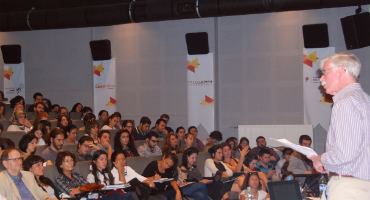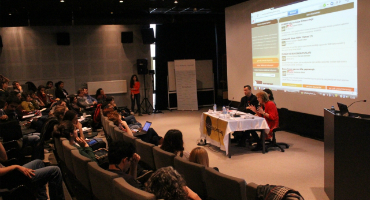The last event of workshop series on discriminatory discourse in the media and rights-based approach to journalism, entitled ‘Media and Children: Children Under Legal Protection’ was organized in Havak Hall, Anarad Hığutyun Building on December 10, 2015 by Hrant Dink Foundation. During the workshop, Ayşe Beyazova and Melda Akbaş from Istanbul Bilgi University Children’s Studies Unit talked about the media-children relation and analyzed, from children’s rights perspective, the ways in which children under legal protection are constantly portrayed in the media. Abdullah Oskay from Hayat Sende Youth Academy Association mentioned about their studies within the scope of Sosyal Duvarları Yıkalım Project and discussed the possible ways to construct a language which is not discriminatory against children under legal protection.
Firstly, Ayşe Beyazova and Melda Akbaş, talked about the media studies they carry out in order to make children’s voices heard in the public space and analyzed through examples how children under legal protection are represented in newspapers. Beyazova and Akbaş underlined the role news reporters play in constructing the language used in the media., while also pointing at the larger media system, which forces these reporters to produce ‘shock news’ They stated how discriminatory discourse appears in these ‘shock news’ and how children under legal protection are dramatically influenced by this discourse. Although constituting 1/3 of the population, children appear only in the 1,5 % of the news which, according to Beyazova and Akbaş, is a significant indicator that voice of children is not heard in the public space. They also argued that since problems concerning children do not occupy the agenda, children’s rights are neither negotiated nor realized. Additionally, they also maintained that children are depicted in the newspapers, not as individuals with rights, but only as objects of the news; especially children under negative conditions are portrayed as dangerous and responsible for those conditions. Also, they drew attention to the fact that the term ‘children under legal protection’ and expressions reminding the state of its duties and responsibilities are never used. Beyazova and Akbaş emphasized that although children’s identities are openly stated as the perpetrators or the victims of the criminal actions, the other agents are almost never mentioned. Finally, they pointed out that no reference has ever been made to experiences and opinions of children in such news while adults and institutions are frequently quoted as news sources.
Abdullah Oskay, gave details about ‘Sosyal Duvarları Yıkalım’ project which has been carried out under the auspices of Hayat Sende Youth Academy Association. He underlined the fact that children under legal protection consider themselves at the bottom of the social hierarchy in many respects, hence they cannot hold on to the social life as individuals. He stated that, within the scope of ‘Sosyal Duvarları Yıkalım’ project, they struggle to change the discriminatory discourse against children under legal protection and to raise awareness in the society. Oskay gave a brief account of their media survey, analyzed their findings and summarized the communication activities they carried out to achieve their purposes. He drew attention to the fact that positive news about these children are very few in number, in a way necessitating the implementation of such a project; furthermore, he also emphasized that negative news are generally produced about adolescents between 13-18 and girls make up the majority of this group. Oskay mentioned that among the news surveyed as part of the project, news about ‘abuse’ ranked first and it is followed respectively by ‘humiliation’ and ‘suicide’. Oskay ended his presentation with the introduction of ‘dogrusozluk’, a dictionary, concerning children under legal protection, which was prepared for the use of media workers.
The workshop continued with a discussion about the dilemmas of the institutional care and the emotional and cognitive problems it created in children, as well as the differences of foster care models adopted by various countries. The workshop ended with the concluding remarks about possible efforts to improve the portrayal of the children under legal protection in the media.





